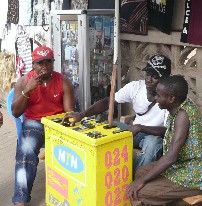

| Home |
 |  |
|
|
| Imagine your unlimited creativity |
Change Password, |
|
CCS Dash Board |
Section:STAa8 Infants' Development Select Other Sections |
 |
Category:STAa84 Manual Maneuver Select Other Categories |
 |
Forum: |
 Sri Lanka - Community Water Supply and Sanitation Project
Sri Lanka - Community Water Supply and Sanitation Project |
| E-mail: The World Bank | Unit: | |
| Answer: demand-responsive community-based W&S services are likely to have sustainable impacts on poverty alleviation and that sustainability of services was markedly higher in communities where households had made informed choices about whether to build a water system and about the type and level of service | Hampstead Heath, London, in April | |
| Sequence: Assign a number (with decimals) determining the sequence of your question.: The World Bank. 1998. Sri Lanka - Community Water Supply and Sanitation Project. The World Bank, Operations Evaluation Department | Map: 1998-06-30 00:00:00 | |
 Community-based approach paying attention to the existing social capital Community-based approach paying attention to the existing social capital | ||||||
| Community-based W&S services are likely to perform better and have stronger impacts in communities with high levels of social capital Project designers need to pay close attention to existing levels of social capital in communities, and adjust the approach to service delivery accordingly. The existence of social networks improves group organization and service functioning, since community members are accustomed to working together as a group. Also, social ties among community members deter free riding and encourage community members to hold to their commitments. Therefore, in the design of projects that finance community-based W&S services-and in particular in the design of social mobilization efforts-the existing levels of social capital in communities needs to be taken into account. In communities with low level of social capital, special efforts may be necessary to motivate and mobilize community members. Success in one community activity often leads a village to success in a subsequent activity. | ||||||
 Rules should be clarified Rules should be clarified | ||||||
| Rules need to be clear, well understood, and accepted by all stakeholders. The study findings on social capital highlights the importance of those rules that govern the use, operation, and maintenance of W&S, services by the water users. Of course, he effectiveness of water committees influences the performance of the W&S service: they provide users with incentives to contribute the required inputs to the design, construction, and O&M of W&S services. And they develop rules. Whether these rules exist in the first place-and whether they are properly implemented and enforced-depends on the social mobilization efforts of the project implementers. For example, whether women participate in service design and management, whether households contribute to construction and pay for water (as agreed), depends partly on the project rules. | ||||||
 Involvement of women is the key Involvement of women is the key | ||||||
| Involve women in the design and management of the W&S service. The results of this study provide strong evidence that involvement of users in all aspects of water supply system development, implementation, and O&M can improve sustainability Involving women makes particularly good sense because women are the primary system users. Women's involvement in system management is critical for performance: women are the primary water collectors in most rural households, and have the most interest in ensuring that the W&S service matches their needs and performs well. | The Putnam index is an index of social capital that is the product of the number of groups a household is a member of and the characteristics of the group. Unlike the results with two community activities, the difference between the means of this measure of social capital is not statistically significant. The relationships between social capital and the functioning of village-managed water supply schemes will be explored further in a subsequent paper that integrates data from a number of rural water projects around the world. | |||||
 Five Recommendations Five Recommendations | ||||||
| The project implementers role, the communities' role, and the functions of local committees and other groups (and the rules that govern their behavior) need to be specified clearly and designed early in the project cycle to facilitate broad participation in all aspects of project development. Government and NGO participation is also governed by project rules. Whether they carry out their tasks as planned and provide accurate and helpful information to community members about technology and service options, and to teach community members about better hygiene practices, critically affects the delivery of decentralized W&S services.
Project design should respond to village aspirations for high service standards. In the past few years, aspirations have steadily risen, even in very poor countries. Local people have little incentive to participate actively if the service they are going is not satisfactory. This extends the previous results on social capital obtained by Narayan and Pritchett (1997). They found that villages in Tanzania with high levels of social capital have better public services and more communal road construction and maintenance activities than villages with low social capital. Design for full coverage and equitable distribution. Many systems have difficulty providing adequate service to critical areas such as hilltops. An extremely common pattern is that systems are designed for only the original number of users that express interest and pay their quota. Once the rest of the community sees that a system was really built, however, they begin applying pressure on the executive committee to include more families. Systems usually expand until the quality of service approaches the intolerable. For that reason, it is better to design for full coverage and to levy a significant surcharge for each system expansion. |
Many unexpected social factors are related to good cost recovery. Factors such as participation in multiple community activities by user group members, participation in system design, participation in system construction, improved beneficiary health, and satisfactory participation in the water group by women are all related to above-average cost recovery. Consequently, during project design, special attention needs to be given to these and related areas. Pay close attention to existing levels of social capital in target communities. Adjusting the approach to service delivery according to existing levels of social capital should prove beneficial. Community-based W&S services are likely to perform better and have stronger impacts in communities with high levels of social capital. The existence of social networks improves group organization and service functioning, and success in any endeavor which benefits the community leaves a village better able to meet the next challenge. In communities with low levels of social capital, special efforts may be needed to ensure that local organizations succeed in a few activities before commencing something as challenging as a water scheme; the type of social mobilization efforts that will be conducted should be considered carefully and piloted during the design phase. | |||||
| Anybody who read this case study can participate in the evaluation of this socail business concept | ||||||
| Social Impact | Mutual Help Model | Social Inclusion | Business Sustainability | Replicability | Evaluation Total | |
| Your Evaluation (1:Lowest to 5:Highest) | 3 | 3 | 3 | 3 | 3 | 3 |
|
|
|
| Average Score sent by users 3 Number of Rators 1 | ||||||
| for authors: | ||||||
|
|
| |||||
|
| ||||||
| More information | Using Services | Analysis | |||
| Networking | Who are eligible and how to use services? | Look at city master plan | |||
| You can apply to local services online | Find contacts in local government offices | Self diagnosis of your welfare challengestd> | |||
| See official events and put your own events | Information on public and private facilities | Look at the performance indicators | |||
| Find good community-business chances | Ask questions, send your opinions and complaints | Case studies of good practices of social services | |||
| You can send local information quickly | Find public reports and documents | Get information on best websites | |||